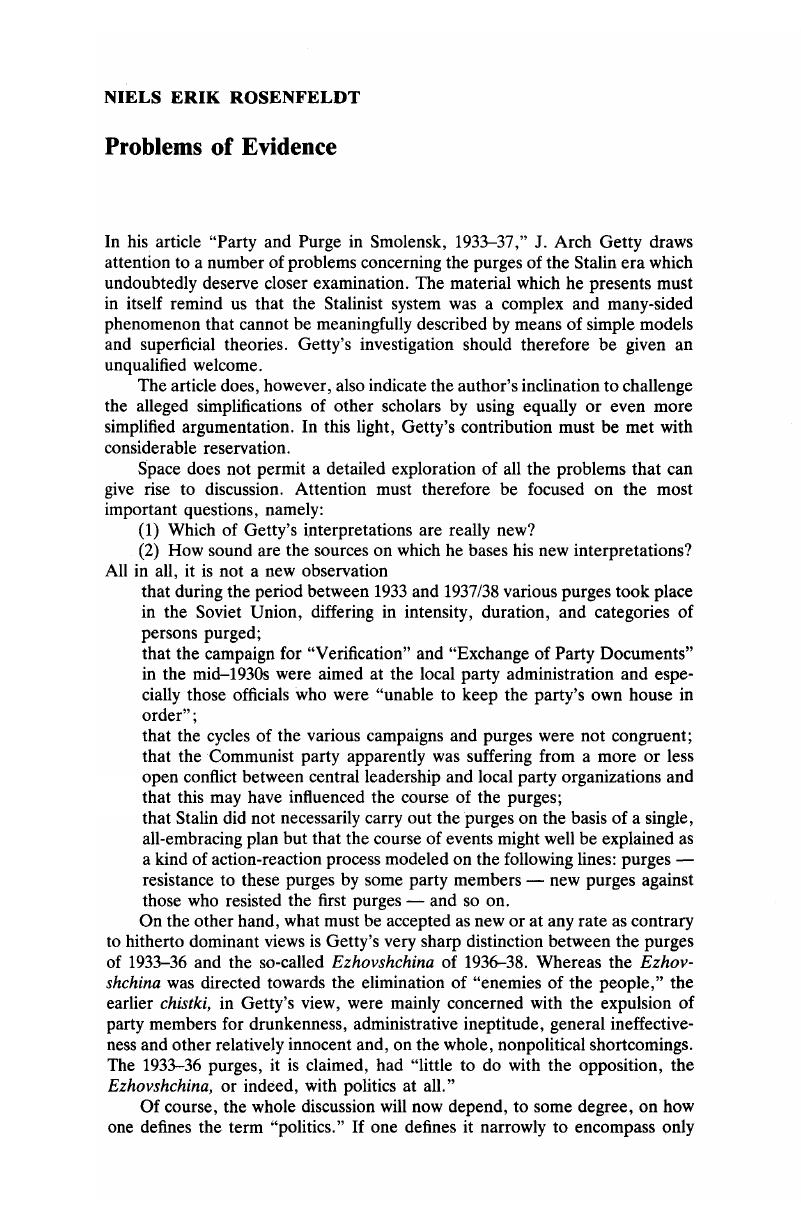Article contents
Problems of Evidence
Published online by Cambridge University Press: 27 January 2017
Abstract

- Type
- Discussion
- Information
- Copyright
- Copyright © Association for Slavic, East European, and Eurasian Studies. 1983
References
1. In this they differed from earlier purges. See, for instance, Partiinoe stroitel'stvo (hereafter, PS), no. 2 (1936): 10.
2. See, for instance, PS, no. 15 (1936): 17 and 34. Cf. Robert, Conquest, The Great Terror: Stalin's Purge of the Thirties, rev. ed. (London, 1973), p. 219 Google Scholar.
3. Cf. The Smolensk Archive (hereafter, SA), File 116/154e, p. 179; KPSS v rezoliutsiakh i resheniakh s“ezdov, konferentsii i plenumov TsK, 1898-1970 gg., 8th ed. (Moscow, 1970-), 5:303- 311; and Conquest, Great Terror, p. 272. The different sorts of criticism leveled against local party secretaries (purging too few or purging too many) are seen by Robert McNeal as a reflection of a struggle between Stalin and Ezhov on the one hand and the “advocates of law and order” in the party on the other. In my opinion, however, this interpretation is based on a fundamental misreading of the sources at hand. McNeal evidently fails to see the ways in which the “Verification of Party Documents,” the “Exchange of Party Documents,” and the simultaneous purge operations were connected. He detects discrepancies between Soviet texts where no such discrepancies exist. He ignores the fact that the warnings against purging too few and the charges of purging too many normally referred to different categories of purge victims (first and foremost “political” versus “nonpolitical” categories, see below), which means that they were not mutually inconsistent and may well have been inspired by the same political decision maker. Finally, he does not even consider the possibility that Stalin may have attempted to turn the “grass roots” of the party against the local leadership by accusing the party secretaries of overzealous purging. See Robert H. McNeal, “The Decisions of the CPSU and the Great Purge,” Soviet Studies, 23, no. 2 (1971): 177-87Google Scholar, and cf. PS, no. 24 (1935): 12-18.
4. Getty, “Party and Purge in Smolensk: 1933-1937,” Slavic Review, 42, no. 1 (1983): 60- 79.
5. See PS, no. 7 (1935): 8-10; no. 15 (1935): 3-5; no. 17 (1935): 4, 22, and 27; no. 21 (1935): 54; no. 2 (1936): 12 and 16; no. 3 (1936): 3-6; no. 5 (1936): 15; no. 16 (1936): 3-9; KPSS v rezoliutsiiakh, 5:243-49; SA, WKP 499, p. 308 and SA, File U6ll54e, pp. 79 and 83. According to Soviet sources, it was not only a question of untrustworthy individuals: whole organizations within the party were engaged in espionage and “Trotskyite” propaganda in 1935. Getty is not the only one to ignore this evidence. Robert McNeal, for example, claims that the pre-Ezhovshchina purge was still not linked to the struggle against Trotskyist subversion (!). See McNeal, “The Decisions of the CPSU,” p. 180.
6. See, for instance, PS, no. 1-2 (1935): 37; no. 5 (1935): 8-9 and 39-40; no. 15 (1935): 5; no. 18 (1936): 9; KPSS v rezoliutsiakh, 5:243; and SA, WKP 499, p. 308.
7. See, for instance, PS, no. 7 (1935): 8; no. 15 (1935): 2-5; no. 17 (1935): 4 and 22; no. 19-20 (1935): 43; no. 21 (1935): 54; no. 3 (1936): 3-6; SA, WKP 186, p. 137.
8. See PS, no. 7 (1935): 10; no. 15 (1935): 2-5; no. 17 (1935): 4 and 22; no. 19-20 (1935): 44; no. 9 (1936): 19-20.
9. SA, WKP384, p. 144; PS, no. 17 (1935): 20; Rigby, T. H., Communist Party Membership in the USSR, 1917-1967 (Princeton, 1968), pp. 207–208 Google Scholar; and Merle, Fainsod, Smolensk Under Soviet Rule (New York, 1958), pp. 299–300 Google Scholar.
10. See, for instance, PS, no. 17 (1935): 4; no. 2 (1936): 11-21; no. 16 (1936): 6; cf. Rigby, Communist Party Membership, p. 204.
11. XVIII s“ezd vsesoiuznoi kommunisticheskoi partii (b), 10-21 marta 1939 g.: stenograficheskii otchet (Moscow, 1939), p. 175. Cf. ibid., pp. 183 and 238. Getty is probably right in saying that no Soviet source or account has ever referred to the Ezhovshchina as a chistka. But Soviet party leaders seem to have regarded the total purge operation between the Seventeenth and Eighteenth Party Congress, including the Ezhovshchina, as an ochishchenie, or “cleansing.” This subtle terminological difference should not be used as a basis for far-reaching conclusions
12. See PS, no. 16 (1936): 3-9; no. 18 (1936): 12; SA, WKP 499, pp. 322-23.
13. The intensity of the Ezhovshchina should not only be measured on the basis of the number of expulsions from the party during the period 1936-38. One must also consider the number of arrests of previously expelled party members as well as of people who had never been in the party at all.
14. XVIII s“ezd, p. 28.
15. See, for instance, PS, no. 3 (1935): 7; no. 5 (1935): 7; no. 15 (1935): 1 and 6. Moreover, the hunt for “class enemies,” “double-dealers,” “alien elements,” “white-guardists” and “Trotskyites- Zinov'evists” had a clear terminological affinity with the purge campaign in the wake of the Kirov murder (cf. for instance, SA, WKP 186, pp. 95 and 98; Conquest, Great Terror, pp. 83 and 88, and Fainsod, Smolensk, p. 222).
16. See, for instance, PS, no. 15 (1935): 6 (where the Kirov murder and the verification letter of May 13,1935 are directly linked); Conquest, Great Terror, p. 88; and Merle, Fainsod, How Russia is Ruled, rev. ed. (Cambridge, Mass., 1963), p. 435 Google Scholar.
17 See, for instance, Conquest, Great Terror, p. 74.
18. See PS, no. 19 (1934): 6-10; no. 22 (1934): 48; no. 1-2 (1935): 37-43; no. 4 (1935): 35; no. 7 (1935): 8.
19. XVIIs“ezd vsesoiuznoi kommunisticheskoi partii (b), 26 ianvaria-10 fevralia 1934 g.: stenograftcheskii otchet (Moscow, 1934), p. 675.
20. See, for instance, PS, no. 1-2 (1935): 37-41.
21. PS, no. 16 (1936): 3-9.
- 1
- Cited by




